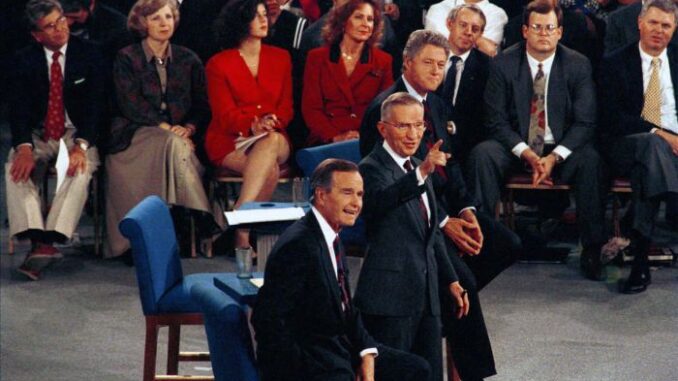
Cross-Posted from DaleGlading.com
_
Had Ross Perot not run as a third-party candidate in 1992, it is reasonable to assume that George H.W. Bush would have been re-elected and Bill Clinton would have become a mere asterisk in the annals of losing presidential campaigns. The same goes for 2000, when Ralph Nader and the Green Party siphoned off just enough votes from Al Gore to catapult George W. Bush into the White House.
In 1968, it can be argued that George Wallace cost Hubert Humphrey the presidency and gift-wrapped it for Richard Nixon instead. And in 1912, Teddy Roosevelt and the Progressive (Bull Moose) Party divided the Republican vote and in doing so, handed the keys to the Oval Office to Woodrow Wilson. However, don’t feel too badly for William Howard Taft, the Republican incumbent, because his consolation prize was an appointment to the U.S. Supreme Court nine years later… as Chief Justice, no less.
And yes, Abraham Lincoln would probably have returned to Illinois to practice law and split rails had John Breckenridge and Stephen A. Douglas not splintered the Democrat vote in 1860. Oh, the tangled webs weaved by third – and sometimes fourth – party candidates throughout American history.
That being said, I am intrigued by the prospect of Robert F. Kennedy, Jr. running as an Independent in 2024. Not because I plan to vote for him, because I don’t, but because it is high time that the Republican and Democratic stranglehold on the presidency comes to an end. And if Joe Manchin also decides to jump into the race under the No Labels banner… well, it’s “the more the merrier” as far as I am concerned.
From 1789 to 1861, there were two Federalist presidents (Washington and John Adams), three Democratic-Republicans (Jefferson, Madison, and Monroe), one National Republican (John Quincy Adams), five Democrats, and four Whigs (only two of which were elected). That’s a nice variety of officeholders, ensuring that no one party dominated the federal government.
However, from 1861 to 2023, there have been 31 different presidents: 19 Republicans and 12 Democrats. That is counting Grover Cleveland twice (#22 and #24) and FDR only once, even though he was elected four times. Those numbers also include unelected presidents who assumed the office when their predecessor was assassinated, died in office, or resigned… although all but Andrew Johnson, Chester Arthur, and Gerald Ford were subsequently elected in their own right.
That’s 162 years of uninterrupted power for the two-party system with every president being either a Republican or a Democrat. In business terms, we call that a monopoly and it’s unhealthy for democracy because it stifles both competition and accountability.
Now before hordes of amateur historians leap to correct me, yes, I am fully aware that America is not a democracy. Rather, it is a constitutional republic and that is a good thing, because government by a simple majority can be problematic – and even dangerous – for those in the minority. However, my point remains that a two-party system offers little incentive for either party to make major adjustments or to be truly responsive to the electorate because even if they lose this election, they are bound to win the next one… or the one after that.
Two hundred and thirty-four years of U.S. presidential history teaches us that, after a few years of one party holding the reins of power, Americans get bored and/or angry and desire a change. And so, they “throw the bums out,” only to elect a member of that same party in a subsequent and not-too-distant election.
Having a viable third or fourth alternative would, if nothing else, hold the Republicans and the Democrats accountable and force them to be on their toes. Citizens who are not well-heeled or well-connected might actually get engaged in the political process and may even run for office themselves. At the very least, a three or four-way contest would shake up the status quo and help to drain the Washington swamp of its career inhabitants.
Yes, with more than two major candidates it would be much harder for one of them to win the 270 electoral votes necessary to ascend to the presidency, in which case the House of Representatives would determine the winner. Each state’s House delegation would cast a singular vote among the top three vote-getters. The Senate would choose the vice president with each senator casting a vote between the top two vote-getters.
This scenario played out in 1824, with the House selecting John Quincy Adams over Andrew Jackson and William H. Crawford, even though Jackson won the most popular and electoral votes in the general election. The difference maker was Henry Clay, who came in fourth and therefore, was not included in the House runoff election. However, Clay threw his support behind Adams, which was enough to put him over the top. In exchange, Adams appointed Clay to be his Secretary of State, creating a furor known as the “Corrupt Bargain.”
But guess what? Our republic survived, just like it did the disputed elections of 1800, 1876, 2000, and 2020. I am confident that it will likewise survive – and perhaps flourish – with more than two serious presidential candidates in 2024.
Bring it on!


